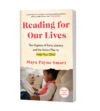By Maya Payne Smart
In reading, as in conversation, it’s not just what we say, but how we say it that matters.
The rhythm, pitch, and intonation someone brings to spoken words can convey meaning far beyond basic definitions. A shaky utterance might indicate fear or uncertainty. Changes in the pitch or speed of speech might accompany a compliment, signal anger, or communicate disappointment. Facial expressions and gestures, too, bring layers of interpretation and significance to text.
Reading fluency is the ability to read a text smoothly with rhythm, expression, and appropriate emotion, and it is a critical literacy skill. Its presence is a telltale sign that a child grasps the meaning of the words they’re reading and can convey their larger sense to others.
But this kind of rhythmic, expressive reading doesn’t just spring naturally from kids’ lips. It’s something that they learn by observation, through conversation, and from instruction.
Hearing parents and others reading aloud models it for kids. But caregivers should go a step further and engage in conversation with kids about how we can use our voices to communicate, by adjusting our tone, pace, and volume accordingly. Such discussion can awaken kids to their vocal power.
Beyond talking about expression, you can teach fluency and provide opportunities to practice it through a range of songs, games, and activities, including wordless picture book “readings.”
Check out a post by Jessica “Culture Queen” Hebron about how to use wordless picture books to teach reading fluency concepts.


